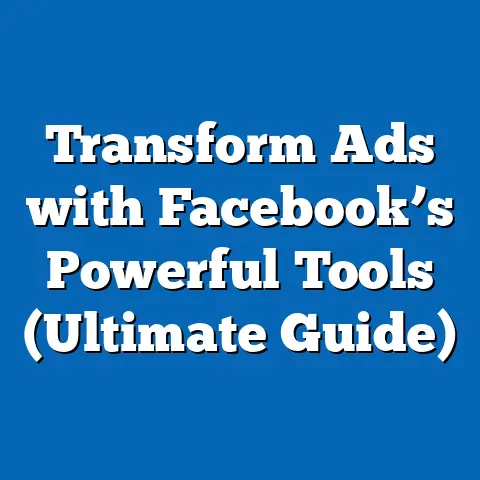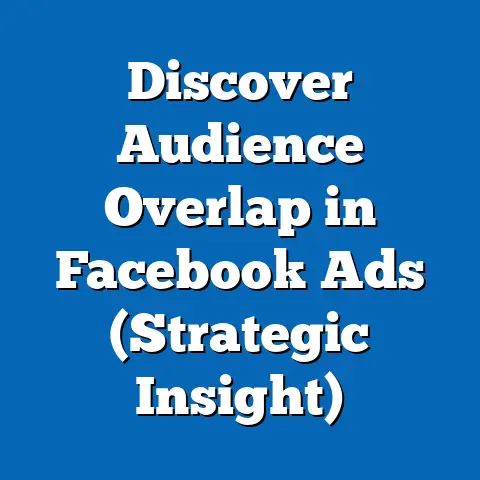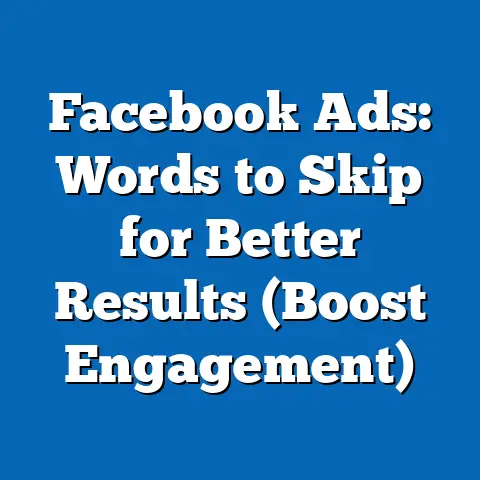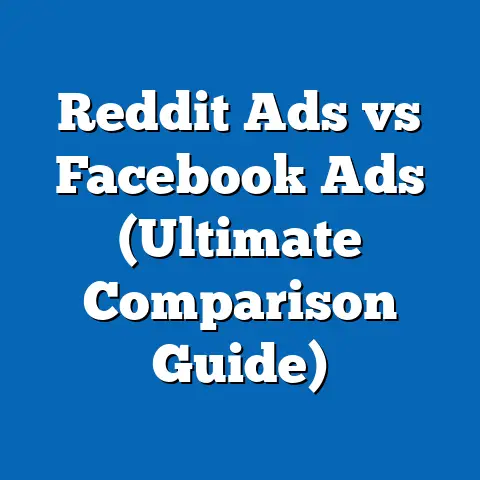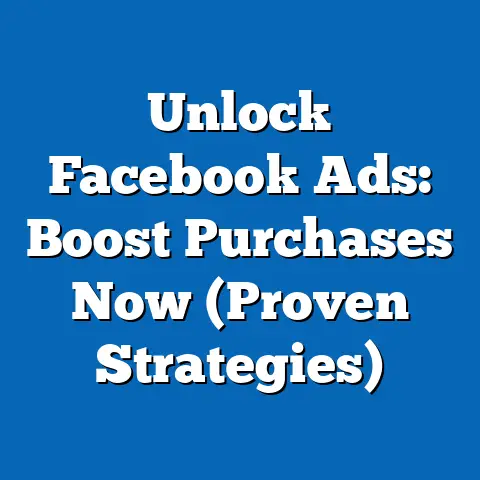Revamp Facebook Ads for Greater Impact (Pro Strategies)
In today’s fast-paced digital world, advertising is no longer a luxury but a necessity for businesses to thrive. Think of it as the lifeblood of your company, pumping vital energy into your sales and overall growth. But what happens when that lifeblood becomes sluggish, when your advertising efforts start yielding diminishing returns? The stress and anxiety that follow can be overwhelming. I’ve seen it firsthand, businesses struggling, pouring money into Facebook ads that just don’t deliver. It’s like watching a patient slowly decline, and it’s a situation nobody wants to be in.
The good news is, just like a doctor can revitalize a patient, we can revive your Facebook ad strategy. By revamping your approach with proven, professional strategies, you can not only alleviate the stress of ineffective marketing but also pave the way for improved financial health and stability.
I remember working with a local bakery, “Sweet Surrender,” that was on the verge of closing down. They had been running Facebook ads for months, targeting a broad audience with generic messaging. Their sales were stagnant, and the owner, Sarah, was visibly stressed. We completely overhauled their strategy, focusing on hyper-local targeting, showcasing mouth-watering images of their signature pastries, and running limited-time offers. Within weeks, their online orders skyrocketed, foot traffic increased, and Sarah’s stress levels visibly decreased. She even told me she was finally sleeping through the night! This is the power of a well-executed Facebook ad revamp.
According to recent statistics, businesses that actively optimize their Facebook ad campaigns see an average increase of 20% in lead generation and a 15% boost in sales conversions. These numbers aren’t just abstract figures; they represent real opportunities for growth and stability.
Facebook, with its billions of active users, remains a powerhouse for advertisers. It’s a platform where you can reach diverse audiences, connect with potential customers on a personal level, and build a thriving community around your brand. But to harness this potential, you need to move beyond basic ad creation and embrace a more strategic, data-driven approach.
Understanding the Facebook Advertising Landscape
The world of Facebook advertising is constantly evolving. What worked yesterday might not work today. To stay ahead of the curve and ensure your ads are effective, it’s crucial to understand the current landscape.
Think of Facebook as a bustling city. To navigate it successfully, you need to know the lay of the land, the traffic patterns, and the hidden gems. This section will provide you with a map of the Facebook advertising landscape, helping you understand its key features and navigate it with confidence.
The Evolution of Facebook Ads
Facebook ads have come a long way since their humble beginnings. Initially, they were simple text-based ads with limited targeting options. Over time, Facebook has introduced a plethora of features and formats, including:
- Image Ads: Still a classic, image ads are visually appealing and can be highly effective when paired with compelling copy.
- Video Ads: Video is king in the digital world. Video ads capture attention, tell stories, and drive engagement.
- Carousel Ads: Showcase multiple products or services in a single ad unit, allowing users to swipe through different options.
- Collection Ads: Designed for e-commerce businesses, collection ads allow users to browse and purchase products directly from the ad.
- Instant Experience Ads (formerly Canvas Ads): Create immersive, full-screen experiences that load instantly on mobile devices.
- Lead Ads: Collect leads directly from Facebook without requiring users to leave the platform.
These are just a few examples of the many ad formats available on Facebook. The key is to experiment with different formats and find the ones that resonate best with your target audience.
One of the biggest changes I’ve seen over the years is the increasing emphasis on personalization. Facebook’s algorithm is constantly learning about users’ interests and behaviors, allowing advertisers to target them with highly relevant ads. This means that generic, one-size-fits-all ads are no longer effective. You need to tailor your messaging and visuals to appeal to specific segments of your audience.
Decoding the Facebook Algorithm
Ah, the Facebook algorithm! It’s often described as a mysterious black box, but understanding its basic principles is essential for success. The algorithm, also known as “EdgeRank” in its early days, determines which content users see in their News Feeds. It’s constantly evolving, but here are some key factors that influence its decisions:
- Relevance: Facebook prioritizes content that it believes is relevant to each user. This is based on their past interactions, interests, and demographics.
- Engagement: Content that generates high levels of engagement (likes, comments, shares, clicks) is more likely to be shown to a wider audience.
- Recency: Newer content is generally given more weight than older content.
- Relationship: Facebook prioritizes content from friends, family, and Pages that users frequently interact with.
So, how can you leverage this knowledge to improve your ad performance? Here are a few tips:
- Create High-Quality Content: Focus on creating ads that are engaging, informative, and visually appealing.
- Target the Right Audience: Use Facebook’s targeting options to reach users who are genuinely interested in your products or services.
- Encourage Engagement: Ask questions, run contests, and create interactive experiences to encourage users to interact with your ads.
- Stay Up-to-Date: Keep abreast of the latest algorithm changes and adjust your strategy accordingly.
I remember a time when simply posting frequently was enough to get your content seen. But those days are long gone. Now, it’s all about quality over quantity. Focus on creating content that resonates with your audience and encourages them to take action.
Understanding Facebook User Demographics
Facebook boasts a massive and diverse user base, but understanding the demographics of its users is crucial for effective targeting. Here’s a snapshot of Facebook’s user demographics:
- Age: While Facebook is popular across all age groups, it’s particularly strong among users aged 25-54.
- Gender: The gender distribution on Facebook is fairly balanced, with slightly more female users than male users.
- Location: Facebook is a global platform, but the majority of its users are located in Asia, Europe, and North America.
- Interests: Facebook users have a wide range of interests, from hobbies and entertainment to news and politics.
Knowing these demographics can help you tailor your ads to appeal to specific segments of the Facebook user base. For example, if you’re targeting young adults, you might use more informal language and trendy visuals. If you’re targeting older adults, you might focus on providing valuable information and building trust.
I once worked with a company that was selling retirement planning services. They were running Facebook ads targeting a broad audience, but their results were underwhelming. We refined their targeting to focus on users aged 50+, who were interested in topics like retirement planning, finance, and travel. We also used images of happy, active retirees enjoying their golden years. The results were dramatic, with a significant increase in leads and conversions.
Key Takeaway: Understanding the Facebook advertising landscape is essential for success. By staying up-to-date on the latest trends, decoding the algorithm, and understanding user demographics, you can create more effective ads and achieve your marketing goals.
Next Step: Take some time to research the latest Facebook advertising trends and algorithm updates. Use Facebook Audience Insights to learn more about your target audience and their interests.
Setting Clear Objectives for Facebook Ads
Before you even think about creating your first Facebook ad, it’s crucial to define your objectives. What do you want to achieve with your advertising efforts? Are you trying to increase brand awareness, generate leads, drive sales, or something else entirely?
Think of it like setting a destination for a road trip. You wouldn’t just hop in your car and start driving without knowing where you’re going, would you? Similarly, you shouldn’t launch a Facebook ad campaign without a clear destination in mind.
The Importance of Defining Objectives
Setting clear objectives is essential for several reasons:
- It Provides Direction: Objectives give your advertising efforts a clear sense of purpose and direction.
- It Helps You Measure Success: Without objectives, it’s impossible to determine whether your ads are actually working.
- It Guides Your Strategy: Objectives influence every aspect of your ad campaign, from targeting and messaging to budgeting and bidding.
- It Improves ROI: By focusing on specific objectives, you can optimize your ads for maximum return on investment.
I’ve seen countless businesses waste money on Facebook ads simply because they didn’t have clear objectives. They were just throwing money at the platform, hoping something would stick. This is a recipe for disaster. You need to be strategic and intentional with your advertising efforts.
Types of Facebook Ad Objectives
Facebook offers a variety of ad objectives, each designed to achieve a specific outcome. Here are some of the most common objectives:
- Awareness: Increase brand awareness and reach a wider audience.
- Traffic: Drive traffic to your website or landing page.
- Engagement: Increase engagement with your Facebook Page or posts (likes, comments, shares).
- Leads: Collect leads from potential customers.
- App Installs: Drive downloads of your mobile app.
- Video Views: Increase views of your video content.
- Messages: Encourage users to send you messages on Facebook Messenger.
- Conversions: Drive sales or other desired actions on your website or app.
- Catalog Sales: Promote products from your e-commerce catalog.
- Store Traffic: Drive foot traffic to your physical store.
The best objective for you will depend on your specific business goals. If you’re a new business trying to build brand awareness, you might start with the “Awareness” objective. If you’re an e-commerce business trying to drive sales, you might focus on the “Conversions” or “Catalog Sales” objectives.
Aligning Objectives with Business Goals
It’s important to align your Facebook ad objectives with your overall business goals. Don’t just choose an objective at random. Think about what you’re trying to achieve as a business and choose the objective that will help you get there.
For example, if your business goal is to increase revenue by 20% in the next quarter, you might focus on the “Conversions” objective and create ads that drive sales of your products or services. If your business goal is to build a larger email list, you might focus on the “Leads” objective and create ads that offer a free e-book or other valuable resource in exchange for an email address.
I always tell my clients to start with the end in mind. What do you want your business to look like in 6 months, a year, or even 5 years? Let your long-term goals guide your short-term advertising objectives.
Tracking Objectives and Measuring Success
Once you’ve set your objectives, it’s crucial to track your progress and measure your success. Facebook provides a variety of metrics that you can use to track your ad performance, including:
- Reach: The number of unique users who saw your ad.
- Impressions: The number of times your ad was displayed.
- Clicks: The number of times users clicked on your ad.
- Click-Through Rate (CTR): The percentage of impressions that resulted in clicks.
- Cost Per Click (CPC): The average cost of each click on your ad.
- Conversions: The number of desired actions that users took after seeing your ad (e.g., purchases, sign-ups, form submissions).
- Cost Per Conversion (CPC): The average cost of each conversion.
- Return on Ad Spend (ROAS): The amount of revenue generated for every dollar spent on advertising.
By tracking these metrics, you can get a clear picture of how your ads are performing and identify areas for improvement. You can also use this data to adjust your strategy and optimize your ads for maximum impact.
I recommend creating a simple spreadsheet to track your key metrics on a daily or weekly basis. This will help you stay on top of your ad performance and identify any trends or anomalies.
Key Takeaway: Setting clear objectives is essential for effective Facebook advertising. By aligning your objectives with your business goals, tracking your progress, and measuring your success, you can ensure that your ads are delivering the results you want.
Next Step: Take some time to define your Facebook ad objectives. Think about what you want to achieve with your advertising efforts and choose the objectives that will help you get there. Create a spreadsheet to track your key metrics and monitor your progress.
Crafting Compelling Ad Content
Now that you’ve defined your objectives and understand the Facebook advertising landscape, it’s time to dive into the heart of your ads: the content. Compelling ad content is what grabs attention, sparks interest, and ultimately drives action. It’s the key to transforming casual scrollers into engaged customers.
Think of your ad as a conversation starter. You have just a few seconds to make a good impression and convince someone to learn more. This section will equip you with the tools and techniques you need to craft ad content that resonates with your target audience and achieves your objectives.
The Art of Engaging Ad Copy
Your ad copy is your opportunity to tell a story, highlight the benefits of your product or service, and persuade users to take action. Here are some tips for writing engaging ad copy:
- Know Your Audience: Understand their pain points, desires, and motivations. Use language that resonates with them.
- Highlight Benefits, Not Features: Focus on how your product or service will improve their lives. What problems will it solve? What benefits will they experience?
- Use Strong Headlines: Your headline is the first thing users will see. Make it attention-grabbing and compelling.
- Keep it Concise: People have short attention spans. Get to the point quickly and avoid unnecessary jargon.
- Use a Clear Call-to-Action (CTA): Tell users exactly what you want them to do (e.g., “Shop Now,” “Learn More,” “Sign Up”).
- Test Different Versions: A/B test different headlines, body copy, and CTAs to see what performs best.
I’ve found that storytelling is one of the most effective ways to engage users. Share a customer testimonial, tell a personal anecdote, or create a narrative that connects with your audience on an emotional level.
I remember working with a local coffee shop that was struggling to attract new customers. We created a Facebook ad campaign that told the story of their coffee beans, from the farms where they were grown to the roasting process and the final cup of coffee. We used beautiful images and videos to bring the story to life. The results were amazing, with a significant increase in foot traffic and online orders.
The Power of Visuals
In the visually driven world of social media, your ad visuals are just as important as your copy. High-quality images and videos can capture attention, convey your message, and create a lasting impression. Here are some tips for using visuals effectively:
- Use High-Quality Images: Avoid blurry or pixelated images. Use professional-quality photos that showcase your products or services in the best light.
- Use Eye-Catching Colors: Choose colors that are visually appealing and consistent with your brand.
- Use Videos to Tell Stories: Videos are a powerful way to engage users and convey your message in a dynamic way.
- Use Text Overlays Sparingly: Don’t overcrowd your visuals with text. Keep it simple and easy to read.
- Test Different Visuals: A/B test different images and videos to see what performs best.
I always recommend using authentic, user-generated content (UGC) whenever possible. UGC is content created by your customers, such as photos, videos, and reviews. It’s more authentic and trustworthy than traditional advertising and can be highly effective at driving engagement and conversions.
Exploring Interactive Ad Formats
Facebook offers a variety of interactive ad formats that can enhance user engagement and drive results. Here are a few examples:
- Carousel Ads: Showcase multiple products or services in a single ad unit, allowing users to swipe through different options.
- Collection Ads: Designed for e-commerce businesses, collection ads allow users to browse and purchase products directly from the ad.
- Instant Experience Ads (formerly Canvas Ads): Create immersive, full-screen experiences that load instantly on mobile devices.
These interactive ad formats can be highly effective at capturing attention and driving engagement. They allow you to tell a more complete story, showcase multiple products, and create a more immersive experience for users.
Analyzing High-Performing Ads
One of the best ways to learn how to create compelling ad content is to analyze high-performing ads in your industry. What are they doing well? What elements make them successful?
Pay attention to the following elements:
- Headline: Is it attention-grabbing and compelling?
- Body Copy: Is it concise, clear, and persuasive?
- Visuals: Are they high-quality, eye-catching, and relevant?
- Call-to-Action: Is it clear, concise, and actionable?
- Targeting: Who are they targeting?
- Engagement: How are users responding to the ad?
By analyzing these elements, you can get a better understanding of what works and what doesn’t. You can also use this knowledge to inspire your own ad creation.
Key Takeaway: Crafting compelling ad content is essential for success on Facebook. By understanding your audience, highlighting benefits, using strong visuals, and exploring interactive ad formats, you can create ads that grab attention, spark interest, and drive action.
Next Step: Analyze high-performing ads in your industry. Identify the elements that make them successful and use this knowledge to inspire your own ad creation. A/B test different headlines, body copy, and visuals to see what performs best.
Advanced Targeting Strategies
Creating compelling ad content is only half the battle. To truly maximize your impact on Facebook, you need to target the right audience. Think of it as aiming a bow and arrow. You can have the most beautiful arrow in the world, but if you’re aiming in the wrong direction, you’re never going to hit your target.
Facebook offers a wide range of targeting options that allow you to reach specific segments of its user base. This section will explore advanced targeting strategies that can help you reach your ideal customers and achieve your marketing goals.
Understanding Facebook’s Targeting Options
Facebook’s targeting options are incredibly powerful. They allow you to reach users based on a variety of factors, including:
- Demographics: Age, gender, location, education, relationship status, job title, and more.
- Interests: Hobbies, activities, pages they like, and topics they follow.
- Behaviors: Purchase history, device usage, travel habits, and more.
- Custom Audiences: Upload your own customer data (e.g., email addresses, phone numbers) to target existing customers or create lookalike audiences.
- Lookalike Audiences: Reach new users who are similar to your existing customers.
The key is to use these targeting options strategically to reach the users who are most likely to be interested in your products or services.
I’ve seen businesses achieve incredible results by using Facebook’s targeting options effectively. For example, I worked with a local bookstore that was struggling to compete with online retailers. We created a Facebook ad campaign targeting users who were interested in books, reading, and local events. We also used custom audiences to target existing customers and create lookalike audiences. The results were fantastic, with a significant increase in foot traffic and online sales.
Leveraging Custom Audiences
Custom Audiences are one of the most powerful targeting options on Facebook. They allow you to target users based on your own customer data. You can upload a list of email addresses, phone numbers, or Facebook IDs to create a custom audience.
There are several ways to use custom audiences effectively:
- Target Existing Customers: Re-engage existing customers with special offers, new product announcements, or loyalty rewards.
- Target Website Visitors: Retarget users who have visited your website but haven’t made a purchase.
- Target App Users: Re-engage users who have downloaded your mobile app but haven’t used it in a while.
- Create Lookalike Audiences: Find new users who are similar to your existing customers.
I always recommend starting with your existing customers. They’re already familiar with your brand and are more likely to convert. You can also use custom audiences to identify your most valuable customers and create lookalike audiences to reach new users who are similar to them.
Creating Lookalike Audiences
Lookalike Audiences allow you to reach new users who are similar to your existing customers. Facebook analyzes the characteristics of your source audience (e.g., existing customers, website visitors) and finds new users who share similar traits.
There are several factors to consider when creating a lookalike audience:
- Source Audience Size: The larger your source audience, the more accurate your lookalike audience will be.
- Similarity Percentage: You can choose how similar you want your lookalike audience to be to your source audience. A smaller percentage will result in a more targeted audience, while a larger percentage will result in a broader audience.
- Location: You can target users in specific locations.
I’ve found that lookalike audiences are particularly effective for businesses that are trying to expand their reach and acquire new customers. They allow you to tap into a pool of potential customers who are already likely to be interested in your products or services.
Audience Segmentation
Audience segmentation is the process of dividing your target audience into smaller groups based on shared characteristics. This allows you to create more targeted and relevant ads for each segment.
There are several ways to segment your audience:
- Demographics: Age, gender, location, education, relationship status, job title, and more.
- Interests: Hobbies, activities, pages they like, and topics they follow.
- Behaviors: Purchase history, device usage, travel habits, and more.
- Customer Journey Stage: Awareness, consideration, decision, loyalty.
By segmenting your audience, you can create ads that speak directly to their needs and interests. This can lead to higher engagement, click-through rates, and conversions.
I once worked with a clothing retailer that was struggling to reach millennial women. We segmented their audience based on interests and behaviors, creating separate ads for different segments (e.g., fashion bloggers, fitness enthusiasts, travel lovers). The results were dramatic, with a significant increase in engagement and sales.
Key Takeaway: Advanced targeting strategies are essential for maximizing your impact on Facebook. By understanding Facebook’s targeting options, leveraging custom audiences, creating lookalike audiences, and segmenting your audience, you can reach your ideal customers and achieve your marketing goals.
Next Step: Experiment with different targeting options on Facebook. Create custom audiences based on your customer data. Create lookalike audiences to reach new users who are similar to your existing customers. Segment your audience and create targeted ads for each segment.
A/B Testing and Optimization
Even with the most compelling ad content and the most precise targeting, your Facebook ads may not perform as well as you’d hoped. That’s where A/B testing comes in. A/B testing, also known as split testing, is the process of comparing two versions of an ad to see which one performs better. It’s like conducting a scientific experiment on your ads, allowing you to identify the elements that resonate most with your audience.
Think of it as fine-tuning an instrument. You wouldn’t just start playing a song without tuning your instrument first, would you? Similarly, you shouldn’t run a Facebook ad campaign without A/B testing your ads first.
The Importance of A/B Testing
A/B testing is essential for optimizing your Facebook ad performance. It allows you to:
- Identify Winning Elements: Determine which headlines, body copy, visuals, and CTAs resonate most with your audience.
- Improve Click-Through Rates (CTR): Increase the percentage of impressions that result in clicks.
- Lower Cost Per Click (CPC): Reduce the average cost of each click on your ad.
- Increase Conversions: Drive more sales or other desired actions on your website or app.
- Maximize Return on Ad Spend (ROAS): Generate more revenue for every dollar spent on advertising.
I’ve seen businesses double or even triple their conversion rates simply by A/B testing their ads. It’s a powerful tool that can help you unlock the full potential of your Facebook advertising campaigns.
Setting Up A/B Tests
Setting up A/B tests on Facebook is relatively straightforward. Here are the steps:
- Create a Campaign: Choose your campaign objective (e.g., traffic, conversions).
- Create an Ad Set: Define your target audience, budget, and schedule.
- Create Two Ad Versions: Create two versions of your ad with different elements that you want to test (e.g., different headlines, different visuals).
- Run the Test: Facebook will automatically split your budget between the two ad versions and track their performance.
- Analyze the Results: After a certain period of time (e.g., 7 days), analyze the results to see which ad version performed better.
- Implement the Winning Version: Implement the winning ad version in your campaign.
Facebook also offers a built-in A/B testing tool that simplifies the process. You can access it by selecting the “Create Split Test” option when creating a new campaign.
Elements to Test
There are many elements that you can test in your Facebook ads. Here are some of the most common:
- Headline: Test different headlines to see which one grabs the most attention.
- Body Copy: Test different body copy to see which one is most persuasive.
- Visuals: Test different images and videos to see which ones resonate most with your audience.
- Call-to-Action: Test different CTAs to see which one drives the most clicks.
- Targeting: Test different targeting options to see which ones reach the most qualified audience.
- Ad Placement: Test different ad placements (e.g., Facebook News Feed, Instagram Feed) to see which ones perform best.
I recommend testing one element at a time to get the most accurate results. This will allow you to isolate the impact of each element on your ad performance.
Interpreting Results
Interpreting the results of your A/B tests is crucial for making informed decisions about your ad campaigns. Here are some key metrics to consider:
- Impressions: The number of times your ad was displayed.
- Clicks: The number of times users clicked on your ad.
- Click-Through Rate (CTR): The percentage of impressions that resulted in clicks.
- Cost Per Click (CPC): The average cost of each click on your ad.
- Conversions: The number of desired actions that users took after seeing your ad (e.g., purchases, sign-ups, form submissions).
- Cost Per Conversion (CPC): The average cost of each conversion.
Look for statistically significant differences between the two ad versions. If one ad version has a significantly higher CTR or conversion rate, it’s likely the winning version.
I always recommend using a statistical significance calculator to determine whether the differences between your ad versions are statistically significant. There are many free calculators available online.
Continuous Optimization
A/B testing is not a one-time activity. It’s an ongoing process of continuous optimization. You should always be testing new elements and refining your ads to improve their performance.
The Facebook advertising landscape is constantly evolving, so what works today might not work tomorrow. By continuously testing and optimizing your ads, you can stay ahead of the curve and ensure that your campaigns are always performing at their best.
Key Takeaway: A/B testing and optimization are essential for maximizing your impact on Facebook. By testing different elements, interpreting results, and continuously refining your ads, you can improve your click-through rates, lower your cost per click, increase your conversions, and maximize your return on ad spend.
Next Step: Set up A/B tests for your Facebook ads. Test different headlines, body copy, visuals, and CTAs. Analyze the results and implement the winning versions in your campaigns. Make A/B testing a regular part of your Facebook advertising strategy.
Budgeting and Bidding Strategies
Now that you’ve mastered the art of creating compelling ad content and targeting the right audience, it’s time to talk about money. Budgeting and bidding strategies are crucial for maximizing your return on ad spend (ROAS) and achieving your marketing goals without breaking the bank.
Think of it as fueling your car for a long journey. You need to have enough fuel to reach your destination, but you don’t want to waste any fuel along the way. Similarly, you need to allocate enough budget to your Facebook ads to achieve your goals, but you don’t want to waste any money on ineffective ads or targeting.
Understanding Budgeting Options
Facebook offers two main budgeting options:
- Daily Budget: Set a daily budget that Facebook will spend on your ads each day.
- Lifetime Budget: Set a total budget that Facebook will spend on your ads over the entire campaign duration.
The best option for you will depend on your specific needs and goals. If you want to have more control over your spending, you might choose a daily budget. If you want to set a total budget for the entire campaign and let Facebook optimize your spending, you might choose a lifetime budget.
I typically recommend starting with a daily budget and then adjusting it as needed based on your ad performance. This allows you to monitor your spending closely and make sure you’re getting a good return on your investment.
Setting Budgets Effectively
Setting your budget effectively is crucial for achieving your marketing goals. Here are some factors to consider:
- Your Goals: What are you trying to achieve with your Facebook ads? Are you trying to increase brand awareness, generate leads, drive sales, or something else entirely?
- Your Target Audience: How large is your target audience? The larger your target audience, the more budget you’ll need to reach them effectively.
- Your Industry: How competitive is your industry? The more competitive your industry, the more you’ll need to spend to stand out from the crowd.
- Your Ad Performance: How well are your ads performing? If your ads are performing well, you can increase your budget to reach a wider audience. If your ads are not performing well, you should decrease your budget and focus on improving your ad content and targeting.
I always recommend starting with a small budget and then gradually increasing it as you see positive results. This allows you to test your ads and targeting without risking too much money.
Exploring Bidding Strategies
Facebook offers a variety of bidding strategies that you can use to control how much you pay for your ads. Here are some of the most common bidding strategies:
- Highest Volume: Facebook will automatically bid to get you the most results for your budget. This is a good option if you’re new to Facebook advertising or if you want to maximize your reach.
- Cost Per Result Goal: Tell Facebook the average cost you’re willing to pay for each result (e.g., conversion) and Facebook will try to achieve that goal.
- Target ROAS: Tell Facebook the return on ad spend (ROAS) you’re aiming for and Facebook will optimize your bids to achieve that target.
- Manual Bidding: Set your bids manually. This gives you more control over your spending, but it also requires more expertise.
The best bidding strategy for you will depend on your specific goals and your level of experience. If you’re new to Facebook advertising, I recommend starting with the “Highest Volume” bidding strategy. As you gain more experience, you can experiment with other bidding strategies to see which ones work best for you.
Maximizing Return on Ad Spend (ROAS)
Maximizing your return on ad spend (ROAS) is the ultimate goal of any Facebook advertising campaign. Here are some tips for improving your ROAS:
- Target the Right Audience: Use Facebook’s targeting options to reach the users who are most likely to be interested in your products or services.
- Create Compelling Ad Content: Use high-quality images and videos, write engaging ad copy, and include a clear call-to-action.
- A/B Test Your Ads: Continuously test different elements of your ads to see what performs best.
- Optimize Your Bidding Strategy: Experiment with different bidding strategies to see which one delivers the best results for your budget.
- Track Your Results: Track your key metrics (e.g., reach, impressions, clicks, conversions) to see how your ads are performing and identify areas for improvement.
I always tell my clients to focus on the customer journey. From the moment someone sees your ad to the moment they make a purchase, every step of the journey should be optimized for conversion.
Key Takeaway: Budgeting and bidding strategies are crucial for maximizing your return on ad spend (ROAS) and achieving your marketing goals without breaking the bank. By understanding your budgeting options, setting budgets effectively, exploring bidding strategies, and tracking your results, you can ensure that your Facebook advertising campaigns are delivering the results you want.
Next Step: Review your current Facebook advertising budget and bidding strategy. Are you using the most effective options for your goals and your level of experience? Experiment with different budgeting options and bidding strategies to see which ones deliver the best results. Track your key metrics and make adjustments as needed.
Let’s recap the key points:
- Understand the Facebook Advertising Landscape: Stay up-to-date on the latest trends, decode the algorithm, and understand user demographics.
- Set Clear Objectives: Align your objectives with your business goals, track your progress, and measure your success.
- Craft Compelling Ad Content: Understand your audience, highlight benefits, use strong visuals, and explore interactive ad formats.
- Utilize Advanced Targeting Strategies: Leverage custom audiences, create lookalike audiences, and segment your audience.
- Embrace A/B Testing and Optimization: Test different elements, interpret results, and continuously refine your ads.
- Master Budgeting and Bidding Strategies: Understand your budgeting options, set budgets effectively, and explore bidding strategies.
The transformative potential of revamping your Facebook ads with these professional strategies is immense. It’s not just about increasing sales or generating leads; it’s about building a sustainable, thriving business that can withstand the ever-changing digital landscape.
I encourage you to take action today. Don’t let your Facebook ads continue to be a source of frustration and wasted money. Implement the strategies outlined in this guide, and start seeing the positive impact on your business health.
The future of advertising on Facebook is bright. New features and opportunities are constantly emerging, offering even more ways to connect with your target audience and drive results. By staying informed, adapting to change, and continuously optimizing your campaigns, you can ensure that your Facebook ads remain a powerful tool for growth and engagement for years to come.
So, go forth and revamp your Facebook ads with confidence! Your business health depends on it.

